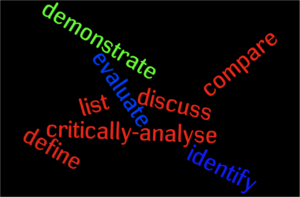Aligning and designing
Aligning and Designing Assessment
In the last module we discussed types of assessment and established some of the key values of assessment (valid, reliable, fair, relevant etc.), and we looked at some definitions, policies, principles and processes surrounding assessment. You were also asked to share your experiences about assessment, as a teacher and as a student.
An important component or value associated with assessment is that it is transparent - meaning there are no unexpected surprises. In other words, effective and well-designed assessment does not set out to 'trick' students, and it must align with the intended learning outcomes. Therefore, the links between the learning outcomes and the assessments must be "plain to see" by the students and also the moderators (Race, Brown & Smith, 2005, p. 2). This transparency relies on you as the assessor providing clear instructions (using appropriate language) for the students.
The language of assessment
The use of language and how that is interpreted is one aspect of assessment that becomes critical to the outcome. You may have a particular understanding of the terminology used but the students may not take the same meaning from those words. For example, students may not understand the difference between an instruction such as outline and another asking them to explain. Therefore, the terms you use need to be defined for students. This allows a common understanding between the person being assessed and the assessor.
|
Identify what the numbered words below mean to you - then click expand to compare your definition with those of the Online Information Literacy module.
For further ideas investigate the list of instruction words and their definitions from the Online Information Literacy module. (This was developed as part of a Tertiary Education Commission (TEC) eLearning Collaborative Development Funded project between the University of Otago, Dunedin College of Education and Otago Polytechnic.)
|
Measuring the effectiveness of Assessment
The type of assessment chosen depends on the purpose of the assessment - is it designed to stimulate and guide learning or to measure whether learning has taken place (achievement)? A quick and simple way to ascertain the effectiveness of the type of assessment you have chosen, is to think about its effectiveness for learning, and also how stressful it is for students to carry out the assessment. The reason being that assessments that are too challenging or stressful have a tendency to inhibit learning. Exam assessments are a prime example where a mismatch often occurs in relation to the value of this type of assessment for learning. Most people can identify with the stress caused by exams, but are they an effective tool for learning? Often it depends on the type of exam and the match with the learning situation. Sue Fostaty Young (2005) describes a case where a group of firefighters who were studying chemistry using experiential and inquiry-based activities became rather disgruntled when faced with a multiple choice exam. Read the article and find out what happened.
|
Regardless of the type of assessment used, it is the learner’s style and preference for learning as well as the level of skill in doing the different types of assessment that influence the effectiveness of the assessment for learning. The effectiveness of an assessment for learning is associated with a number of factors such as how well the assessment: motivates; guides improvement; develops skills for learning, provides feedback; helps understanding, promotes deep learning; measures skills and competencies, and matches the learning goals of the students and the objectives of the course. All assessments need to align with the learning outcomes of a course as well. When considering whether this is the case, it is necessary to have a good grasp on the 'instruction words' used in both the assessment instructions and in the learning outcomes.
|
Models for measuring activity

Several models are presented in this topic to get you thinking about how to design assessments - Bloom's taxonomy (revised and digital), Five Stage model for e-moderating (used for online discussion or interactions online) - Gilly Salmon, and ICE - Ideas, Connections and Extensions. These models are useful places to start when considering the level at which you might assess students' thinking and engagement in the learning and assessment process.
Blooms Revised Taxonomy
An important part of designing assessment is considering what level of thinking you want the learner to demonstrate. This influences your choice of instruction words and the assessment activities. Seven levels of thinking are present in Blooms Revised Taxonomy devised in 2001 by Anderson and Krathwohl. It is important to think about how the six levels (remembering, understanding, applying, analysing, evaluating and creating) relate to the learning outcomes in the course that you are teaching. Also how the instruction words you use for assessments match the six levels of thinking. For this you need to understand and know which descriptors are used at each of the six levels. Check out this website comparing Bloom's original teaxonomy of thinking and the revised taxonomy - both have lots of descriptors to choose from Bloom's taxonomy and Revised Bloom's.
If you are also assessing digital skills and knowledge, Bloom's Digital Taxonomy is a helpful framework to use. Make sure you check out Bloom's Digital Taxonomy Summary Map on this site. It clearly depicts the Higher Order and Lower Order thinking skills associated with using digital tools for learning at the seven levels.
ICE model
The ICE model - Ideas, Connections and Extensions - is simpler to use than Bloom's taxonomy, and could be easier for students to understand what you are wanting them to do. Reference: Fostaty Young, S., & Wilson, R. (2000). The ICE Model of qualitative assessment. Another resource provides more detail about the ICE model with examples of how it can be used.
- Fostaty Young (2005). Teaching, Learning and Assessment in Higher Education: Using ICE to improve student learning. As published in the Proceedings of the Improving Student Learning Symposium, London, UK, 13, 105-115. Imperial College, London, UK, September 2005. Oxford Centre for Staff and Learning Development. Retrieved from http://www.queensu.ca/ctl/resources/topicspecific/assessment/ISL_paper.pdf
Assessing using the ICE model
- Ideas - to assess at this level of thinking, recall of information and facts is important as rote learning, the demonstration of basic skills, understanding concepts and the accumulation of knowledge is foremost.
- Assessment: worksheets, multiple choice, demonstration of practical skills.
- Connections - assessment of this deeper level of learning requires reflection and the ability to link different types of knowledge and understanding. The learner can articulate the relationship between facts and the problem-to be solved.
- Assessment: essays, journals, blogs, portfolios.
- Extensions - assessment at this more advanced level of learning requires evidence that the knowledge can be applied in different situations.
- Assessment: projects, portfolios, experimenting with skills.
Five-Stage model of e-moderating
The Five Stage model can be used to assess online discussions and interactions at five levels - access and motivation, socialisation, information exchange, knowledge construction and development. It was developed by Gilly Salmon for e-moderators (facilitators) to use to stimulate and facilitate online discussions, but it is also a good framework for measuring the depth of thinking in online forum discussions, and the interactions that students engage in when online.
A summary of key points to consider when designing assessments
- Consideration of how the assessment supports learning;
- How assessment provides evidence that the learning outcomes have been met;
- The level of thinking expected;
- Appropriate choices for instruction words;
- Adequate assessment tools (which you will explore in more depth in the next module).
Cultural Diversity and Assessment
Key values of assessment include fairness and relevance. When exploring these values it is also important to consider learners' needs and cultural diversity. Cultural diversity can be defined as: "the quality of diverse or different cultures, as opposed to monoculture, as in the global monoculture, or a homogenization of cultures, akin to cultural decay" (Wikipedia, 2012).
Some definitions follow from the Cultural diversity and community cohesion paper prepared for the Start project. The definitions "embrace Maori as Tangata Whenua, whilst acknowledging ... Maori perspectives" (p. 2). (Reference this resource as: START (n.d.). Cultural Diversity and Community Cohesion. Retrieved from - add Url.)
Culture
This is made up of the systems and processes by which we make sense of the world - the abilities, norms and behaviours we acquire manifest in a constantly evolving set of values, symbols, rituals and institutions. Culture provides the lens through which we, as individuals and societies see the world, the sets of rules by which we treat others and the critical template through which we organise ourselves as societies and form our distinct identities.
Cultural diversity
This embraces a whole range of cultures and corresponding identities which may be layered within the one individual and community to create distinct perspectives on the world. Although other definitions could include communities of interest such as arts, business and global cultures; the scope of this paper is confined to cultures based on fixed, inherent demographic characteristics (gender, ethnicity, age, ability/disability, sexuality); and on religious beliefs, which are both linked to and transcend ethnicities.
The following link to Cultural Diversity Resources will take you to a page that will continue to develop with a range of resources. Hopefully you will find something among them that has relevance to your own context. Please add material that you believe is useful to the page.
|


